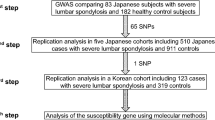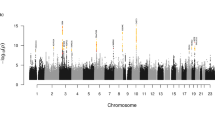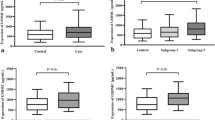Abstract
Lumbar disc disease (LDD) is a common musculo-skeletal disease with strong genetic determinants. In a Finnish population, a single nucleotide polymorphism (SNP) causing an amino-acid substitution (Trp2 allele) in COL9A2, which encodes the α2 (IX) chain of type IX collagen, has been reported to associate with LDD. However, replication studies in different populations have produced controversial results. To further investigate the association of COL9A2 with LDD in Japanese, we examined SNPs in COL9A2, including Trp2, in 470 LDD patients (mean age 35) along with 658 controls (mean age 48). We identified a total of 43 sequence variations in COL9A2. Nine SNPs, including Trp2, were selected and genotyped. After Bonferroni’s correction, none of these SNPs showed association. Unlike observations in the Finnish population, Trp2 was common in Japanese, and no association with LDD was apparent. However, we did see association of a COL9A2 specific haplotype with LDD (P=0.025; permutation test); this association is more significant in patients with severe lumbar disc degeneration (P=0.011). Thus, the association of Trp2 with LDD was not replicated, but COL9A2 susceptibility allele(s) other than Trp2 may be present in Japanese LDD.
Similar content being viewed by others
Introduction
Lumbar disc disease (LDD) consists chiefly of disc degeneration and disc herniation, contributing to the development of low back pain and unilateral leg pain. Low back pain affects 70–85% of all people during their lifetimes, and LDD is the most common cause of activity limitation in individuals younger than 45 years of age (Andersson 1999). Lumbar disc degeneration causes low back pain and discogenic pain (Ito et al. 1998), and herniation is a common cause of radiculopathy manifesting as unilateral leg pain. Studies show that 20% of patients with lumbar disc herniation require surgical treatment during follow-up due to prolonged or aggravated leg pain (Saal and Saal 1989; Komori et al. 2002). Thus, LDD is a significant health issue for individuals and society.
The etiology and pathogenesis of LDD are still largely unknown. LDD has a strong familial component (Varlotta et al. 1991; Matsui et al. 1998), as evidenced by the finding that a positive family history increases the risk for juvenile lumbar disc herniation up to 5.6-fold (Matsui et al. 1992). Twin studies have demonstrated the genetic contribution to degeneration of intervertebral discs of the lumbar spine, observed through magnetic resonance imaging (MRI) (Battie et al. 1995; Sambrook et al. 1999). Recently, several genes have been reported to associate with LDD, most of which encode matrix proteins in the intervertebral disc.
COL9A2, which encodes the α2 (IX) chain of type IX collagen, has been reported to associate with LDD in a Finnish population. Trp2, a rare COL9A2 allele that replaces the wild-type arginine with tryptophan at codon 326 (R326W), was found in 6 of 157 patients (allelic frequency: 1.9%) but was absent in 174 controls (Annunen et al. 1999). A subsequent study of Finnish families revealed that family members who carry the Trp2 allele have a greater degree of degeneration in the vertebral disc and end-plate (Karppinen et al. 2002). However, the Trp2 association was not replicated in a German study of 250 surgically treated patients who experienced disc prolapse of the cervical and lumbar spine (Wrocklage et al. 2000).
In this study, we examined the association of COL9A2 with LDD in the Japanese population. In contrast with the Finnish population, Trp2 is common in Japanese individuals and does not associate with LDD. However, we have identified a haplotype of COL9A2 that associates specifically with severe disc degeneration in LDD.
Materials and methods
Subjects
The study examined 470 patients with LDD and 658 controls, all of whom were Japanese (Seki et al. 2005). The mean ages (range) of the patient and control groups were 35 (13–75) and 48 (13–86) years, respectively. All patients had received radiographic evaluation, including plain radiographs and MRI, and had been treated and monitored for at least 1 year by orthopedic surgeons specializing in spinal diseases. Patients had reported unilateral pain radiating from the back along the femoral or sciatic nerve to the corresponding dermatome of the nerve root for longer than 3 months. The grade of disc degeneration was determined according to Schneiderman’s classification for MRI (Schneiderman et al. 1987), using exclusion criteria as described (Seki et al. 2005). The study protocol was approved by ethical committees at each participating institution, and written informed consent was obtained from all participants prior to joining the study.
SNP discovery and genotyping
Through assembly of GenBank sequences (AF019406 and AL050341), we generated a reference sequence for a ∼24-kb genomic region containing COL9A2. The sequence included 3-kb upstream and downstream regions of the COL9A2 transcribed region. Sequence variations in COL9A2 were identified in public databases or by sequencing the region using 48 genomic DNA samples from the non-affected Japanese population.
Genomic DNA was extracted from peripheral blood using standard procedures, and Trp2 was genotyped by polymerase chain reaction (PCR) and direct sequencing. Other COL9A2 polymorphisms were genotyped using the TaqMan assay (Livak 1999) using a Prism 7700 sequence detector (PE Applied Biosystems, Foster City, CA) according to the manufacturer’s instructions. Conditions for the TaqMan assay were as follows: 50°C for 2 min; 95°C for 10 min; 95°C for 15 s; and 62°C for 1 min, for 40 cycles.
Statistical analysis
For each SNP, a χ 2 test was performed to assess Hardy–Weinberg equilibrium and association between the LDD and control groups based on allelic and genotypic frequencies. The odds ratio (OR) and 95% confidence interval (CI) were calculated with respect to the minor allele compared with the major allele. Pairwise linkage disequilibrium (LD) was estimated as previously described (Seki et al. 2005). Haplotype frequencies and permutation tests were estimated by the expectation-maximization algorism using Haploview software (http://www.broad.mit.edu/mpg/haploview/).
Results
Association analysis
Our association analysis found that Trp2 was under-represented in the Japanese LDD population and showed no association with LDD (Table 1). In contrast with the Finnish population, Trp2 was common in the Japanese population. Given that genotypic risk ratios for Trp2 were calculated to be 1.6-, 2- or 4-fold, the false negative ratios (β) would be 0.05, 0.0075 and 0.0000033, respectively. To examine the possibility that Trp2 is associated with a specific sub-population of LDD, subjects were grouped according to various phenotypes, including age, sex and the severity of disc degeneration. Even after phenotypic sub-grouping, however, Trp2 showed no association.
We identified a total of 43 COL9A2 polymorphisms in addition to Trp2. Of these, we selected and genotyped nine SNPs, including Trp2, which were in the coding region or had minor allele frequencies greater than 20%. One SNP (−2066C>A) showed a positive association (P<0.05); however, after Bonferroni’s correction for multiple testing, no SNP showed significant association with LDD (Table 1).
Haplotype analysis
To search for hidden susceptibility alleles in COL9A2, we examined the haplotype structure of the gene. The LD structure was determined using SNPs with minor allele frequencies equal to or greater than 20% (Table 2). The entire COL9A2 gene was contained in a 13-kb LD block. Three SNPs (−2066C>A, c.977A>G and IVS19+1147G>C) were selected for the haplotype study by SNP tagger (http://www.ihg.gsf.de/ihg/databases.html); they were not in complete LD with each other, as estimated using the Δ measure. We estimated haplotype frequencies for case and control groups, and calculated P value based on 1,000,000 permutations. Through this analysis, we found that the “221” haplotype was over-represented in LDD (P=0.025) (Table 3). Further, this association was more significant when tested for the group with severe (Schneiderman’s grade 10–20) disc degeneration (P=0.011). The Trp2 allele was linked to the “111” haplotype rather than to the “221” haplotype.
Discussion
We were unable to replicate the previously reported association of Trp2 with LDD (Annunen et al. 1999), despite examining more than three times the number of study subjects. Our results may be due to a lack of power in the study; the estimated false negative rate is considerable when the genotypic risk ratio is lower than 1.6, indicating that we might have missed a causal variant with a weak effect. Alternatively, the discrepant results may arise from population differences, as evidenced by the very different allelic frequencies of Trp2 and other SNPs in control groups. Both the Finnish and the Japanese populations are genetically isolated (de la Chapelle 1993; Wright et al. 1999).
It is not surprising that a genetic variant is associated in some populations but not in others. Such inter-study heterogeneity has been reported for many complex common diseases (Wang et al. 2005), and significant heterogeneity between studies on the same topic has been reported in 14 of 36 cases (39%) (Ioannidis et al. 2001). Humans are significantly outbred, with each collection of samples representing an unquantifiable mixture of genetic strains and environments. Therefore, the phenotypic effects of genetic variants will differ considerably among diverse environmental and genetic contexts. The lack of replication in this study does not diminish the value of the Finnish pioneer study. Even if genetic variants are population-specific, COL9A2 remains the gene responsible for LDD, a common disease that affects millions of people. Such variants can help shed light on molecular pathways relating to the gene, providing important clues for identifying additional disease genes in distinct populations.
Type IX collagen is a fibrillar collagen that cross-links with type II collagen on the surface of cartilage collagen fibrils (Nishimura et al. 1989). A heterotrimetric protein, type IX collagen is comprised of α1, α2 and α3 (IX) chains, which are encoded by the COL9A1, COL9A2, and COL9A3 genes, respectively (Perala et al. 1993). In mice, abnormal type IX collagen causes LDD, and the skeletal phenotypes of collagen IX-deficient mice suggest that this protein is essential for the functional longevity of the intervertebral disc (Fassler et al. 1994; Kimura et al. 1996). Transgenic mice expressing mutant α1 (IX) collagen also develop disc degeneration and progressive joint degeneration with age (Nakata et al. 1993); at 20 months, these mice show protrusion of the disc with impingement on the spinal cord, mimicking human herniation (Kimura et al. 1996). These findings, along with the observed association in the Finnish population (Annunen et al. 1999), justify consideration of COL9A2 as a susceptibility gene.
To date, functional data supporting the pathogenesis and causality of Trp2 are lacking. Cartilage samples from individuals homozygous for Trp2 yielded normal amounts of collagen IX that include the α2 chain. The profile of cross-linked peptides and incorporation of the Trp2 product into the cross-linked fibrillar network also were normal in these samples (Matsui et al. 2003). In the Finnish study, linkage was identified more than 10 cM from Trp2 (Annunen et al. 1999). A German study did not replicate the association; Trp2 was found only in three older patients (61–77 years of age) (Wrocklage et al. 2000). Therefore, further study is necessary to confirm the association of Trp2 with LDD and its specific functionality in disease pathogenesis. Meta-analysis, the quantitative assessment of combined results from these studies, would be useful in estimating and explaining their diversity.
We have identified a specific COL9A2 haplotype associated with LDD in the Japanese population. This association also awaits replication. The haplotype itself may confer susceptibility to LDD, or a hidden susceptibility allele may exist within the haplotype. Continued genetic analysis of COL9A2 will help define the molecular mechanisms and pathogenesis of LDD, leading to improved methods for screening, diagnosis, and treatment.
References
Andersson GB (1999) Epidemiological features of chronic low-back pain. Lancet 354:581–585
Annunen S, Paassilta P, Lohiniva J, Perala M, Pihlajamaa T, Karppinen J, Tervonen O, Kroger H, Lahde S, Vanharanta H, Ryhanen L, Goring HH, Ott J, Prockop DJ, Ala-Kokko L (1999) An allele of COL9A2 associated with intervertebral disc disease. Science 285:409–412
Battie MC, Haynor DR, Fisher LD, Gill K, Gibbons LE, Videman T (1995) Similarities in degenerative findings on magnetic resonance images of the lumbar spines of identical twins. J Bone Joint Surg Am 77:1662–1670
De la Chapelle A (1993) Disease gene mapping in isolated human populations: the example of Finland. J Med Genet 30:857–865
Fassler R, Schnegelsberg PN, Dausman J, Shinya T, Muragaki Y, McCarthy MT, Olsen BR, Jaenisch R (1994) Mice lacking alpha 1 (IX) collagen develop noninflammatory degenerative joint disease. Proc Natl Acad Sci USA 91:5070–5074
Ioannidis JP, Ntzani EE, Trikalinos TA, Contopoulos-Ioannidis DG (2001) Replication validity of genetic association studies. Nat Genet 29:306–309
Ito M, Incorvaia KM, Yu SF, Fredrickson BE, Yuan HA, Rosenbaum AE (1998) Predictive signs of discogenic lumbar pain on magnetic resonance imaging with discography correlation. Spine 23:1252–1258
Karppinen J, Paakko E, Raina S, Tervonen O, Kurunlahti M, Nieminen P, Ala-Kokko L, Malmivaara A, Vanharanta H (2002) Magnetic resonance imaging findings in relation to the COL9A2 tryptophan allele among patients with sciatica. Spine 27:78–83
Kimura T, Nakata K, Tsumaki N, Miyamoto S, Matsui Y, Ebara S, Ochi T (1996) Progressive degeneration of articular cartilage and intervertebral discs. An experimental study in transgenic mice bearing a type IX collagen mutation. Int Orthop 20:177–181
Komori H, Okawa A, Haro H, Shinomiya Ki K (2002) Factors predicting the prognosis of lumbar radiculopathy due to disc herniation. J Orthop Sci 7:56–61
Livak KJ (1999) Allelic discrimination using fluorogenic probes and the 5′ nuclease assay. Genet Anal 14:143–149
Matsui H, Kanamori M, Ishihara H, Yudoh K, Naruse Y, Tsuji H (1998) Familial predisposition for lumbar degenerative disc disease. A case-control study. Spine 23:1029–1034
Matsui H, Terahata N, Tsuji H, Hirano N, Naruse Y (1992) Familial predisposition and clustering for juvenile lumbar disc herniation. Spine 17:1323–1328
Matsui Y, Wu JJ, Weis MA, Pietka T, Eyre DR (2003) Matrix deposition of tryptophan-containing allelic variants of type IX collagen in developing human cartilage. Matrix Biol 22:123–129
Nakata K, Ono K, Miyazaki J, Olsen BR, Muragaki Y, Adachi E, Yamamura K, Kimura T (1993) Osteoarthritis associated with mild chondrodysplasia in transgenic mice expressing alpha 1(IX) collagen chains with a central deletion. Proc Natl Acad Sci USA 90:2870–2874
Nishimura I, Muragaki Y, Olsen BR (1989) Tissue-specific forms of type IX collagen-proteoglycan arise from the use of two widely separated promoters. J Biol Chem 264:20033–20041
Paassilta P, Lohiniva J, Goring HH, Perala M, Raina SS, Karppinen J, Hakala M, Palm T, Kroger H, Kaitila I, Vanharanta H, Ott J, Ala-Kokko L (2001) Identification of a novel common genetic risk factor for lumbar disk disease. JAMA 285:1843–1849
Perala M, Hanninen M, Hastbacka J, Elima K, Vuorio E (1993) Molecular cloning of the human alpha 2(IX) collagen cDNA and assignment of the human COL9A2 gene to chromosome 1. FEBS Lett 319:177–180
Saal JA, Saal JS (1989) Nonoperative treatment of herniated lumbar intervertebral disc with radiculopathy. An outcome study. Spine 14:431–437
Sambrook PN, MacGregor AJ, Spector TD (1999) Genetic influences on cervical and lumbar disc degeneration: a magnetic resonance imaging study in twins. Arthritis Rheum 42:366–372
Schneiderman G, Flannigan B, Kingston S, Thomas J, Dillin WH, Watkins RG (1987) Magnetic resonance imaging in the diagnosis of disc degeneration: correlation with discography. Spine 12:276–281
Seki S, Kawaguchi Y, Chiba K, Mikami Y, Kizawa H, Oya T, Mio F, Mori M, Miyamoto Y, Masuda I, Tsunoda T, Kamata M, Kubo T, Toyama Y, Kimura T, Nakamura Y, Ikegawa S (2005) A functional SNP in CILP, encoding cartilage intermediate layer protein, is associated with susceptibility to lumbar disc disease. Nat Genet 37:607–612
Varlotta GP, Brown MD, Kelsey JL, Golden AL (1991) Familial predisposition for herniation of a lumbar disc in patients who are less than twenty-one years old. J Bone Joint Surg Am 73:124–128
Wang X, Ria M, Kelmenson PM, Eriksson P, Higgins DC, Samnegard A, Petros C, Rollins J, Bennet AM, Wiman B, de Faire U, Wennberg C, Olsson PG, Ishii N, Sugamura K, Hamsten A, Forsman-Semb K, Lagercrantz J, Paigen B (2005) Positional identification of TNFSF4, encoding OX40 ligand, as a gene that influences atherosclerosis susceptibility. Nat Genet 37:365–372
Wright AF, Carothers AD, Pirastu M (1999) Population choice in mapping genes for complex diseases. Nat Genet 23:397–404
Wrocklage C, Wassmann H, Paulus W (2000) COL9A2 allelotypes in intervertebral disc disease. Biochem Biophys Res Commun 279:398–400
Acknowledgments
We thank patients for participating this study and the doctors who cooperated in this study. This work was supported by a grant-in-aid from Ministry of Education, Culture, Sports and Science of Japan (Contract grant number: 17209050).
Author information
Authors and Affiliations
Corresponding author
Rights and permissions
About this article
Cite this article
Seki, S., Kawaguchi, Y., Mori, M. et al. Association study of COL9A2 with lumbar disc disease in the Japanese population. J Hum Genet 51, 1063–1067 (2006). https://doi.org/10.1007/s10038-006-0062-9
Received:
Accepted:
Published:
Issue Date:
DOI: https://doi.org/10.1007/s10038-006-0062-9
Keywords
This article is cited by
-
Association between polymorphisms of collagen genes and susceptibility to intervertebral disc degeneration: a meta-analysis
Journal of Orthopaedic Surgery and Research (2021)
-
Collagen IX gene polymorphisms and lumbar disc degeneration: a systematic review and meta-analysis
Journal of Orthopaedic Surgery and Research (2018)
-
Association of CILP, COL9A2 and MMP3 Gene Polymorphisms with Lumbar Disc Degeneration in an Indian Population
Journal of Molecular Neuroscience (2018)
-
Meta-analysis of the effects of genetic polymorphisms on intervertebral disc degeneration
European Spine Journal (2017)
-
Investigation of MMP-1 genetic polymorphisms and protein expression and their effects on the risk of Kashin-Beck disease in the northwest Chinese Han population
Journal of Orthopaedic Surgery and Research (2016)



